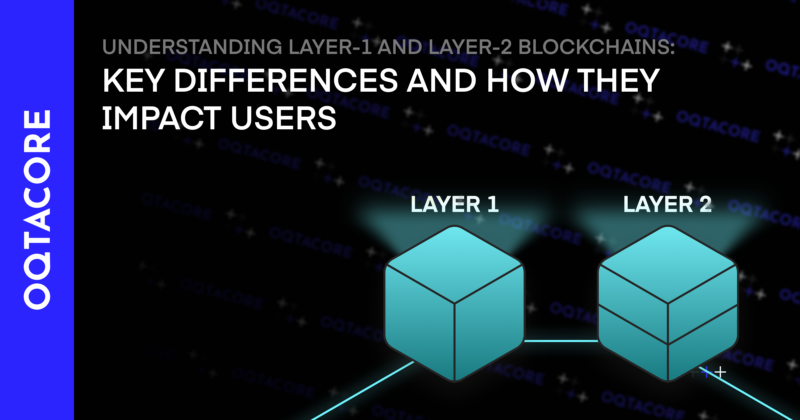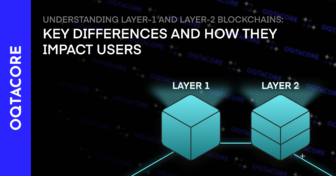
Key Differences and How They Impact Users
Blockchain technology continues to evolve, offering various solutions to scale decentralized networks and improve performance. Among the most commonly discussed blockchain architectures are Layer-1 and Layer-2 platforms. But what exactly do these terms mean, and how do they affect users, developers, and businesses?
In this article, we break down the differences between Layer-1 and Layer-2 blockchains, explain their unique functions, and explore how they contribute to the broader blockchain ecosystem.
What Is a Layer-1 Blockchain?
A Layer-1 blockchain refers to the base layer or the main blockchain network that operates independently. It is the foundational level where transactions are recorded, validated, and stored directly on the blockchain.
Simple Analogy: The Accountant and the Ledger Book
To understand Layer-1, imagine a ledger book kept by an accountant in a small village. This accountant is responsible for recording all transactions that occur between villagers.
For example:
- Alice lends a book to Bob → The accountant writes, “Alice, Bob, book.”
- Bob returns the book to Alice → The accountant writes, “Bob, Alice, book.”
In this analogy, the accountant represents the blockchain, and the ledger book is the blockchain’s record of all transactions. Every transaction is stored directly on the blockchain without the need for intermediaries.
Popular Layer-1 blockchains include Ethereum, Solana, and TON.
Benefits of Layer-1 Blockchains
- Decentralization: Each node in the network has an equal say, and data is stored on multiple nodes.
- Security: Layer-1 blockchains are highly secure because of the consensus mechanisms they use (e.g., Proof of Work or Proof of Stake).
- Transparency: Transactions are publicly recorded on the blockchain and can be verified by anyone.
However, Layer-1 blockchains can have scalability issues, particularly when transaction volume increases. This is where Layer-2 solutions come into play.
What Is a Layer-2 Blockchain?
A Layer-2 blockchain is a secondary framework built on top of a Layer-1 blockchain to enhance scalability, reduce transaction costs, and improve speed. Think of it as a new accountant who helps with the overflow of transactions, allowing the old accountant (Layer-1) to focus on recording the most critical transactions.
Simple Analogy: The Overflow Accountant
Imagine that the old accountant is overwhelmed by the number of villagers lining up to get their transactions recorded. To solve this, a new accountant (Layer-2) steps in to handle some transactions and then submits a summary of these transactions to the old accountant (Layer-1) for final verification.
- The new accountant collects and processes transactions much faster than the old one.
- At the end of the day, the new accountant sends a hash (a compressed summary) to the old accountant, confirming that everything is legitimate.
This process allows Layer-2 to handle much more traffic without overwhelming the original blockchain, which is slower and more expensive to operate. Layer-2 solutions take advantage of the security and trust of Layer-1, while being faster and more cost-efficient.
Popular Layer-2 Blockchains
- Polygon (Matic): Built on Ethereum, Polygon is a Layer-2 solution that scales transactions with lower fees and faster confirmation times.
- Arbitrum: Another Layer-2 solution for Ethereum that uses Optimistic Rollups to batch transactions off-chain before submitting them to the main Ethereum chain.
- zkSync: A Layer-2 solution utilizing Zero-Knowledge Rollups (zk-Rollups) to efficiently batch transactions while ensuring data security.
Benefits of Layer-2 Blockchains
- Faster transactions: Layer-2 solutions process transactions more quickly than Layer-1 blockchains.
- Lower fees: With less congestion on Layer-1, transactions on Layer-2 are more affordable.
- Scalability: Layer-2 can handle large volumes of transactions, which are then periodically committed to the main chain.
Layer-1 vs. Layer-2: Key Differences and Considerations
Trust and Security
When using a Layer-2 solution, the trust and security of transactions are still based on Layer-1, meaning the final confirmation and settlement of transactions are always verified on the Layer-1 blockchain. For example, Polygon or Arbitrum will submit hashes to Ethereum, ensuring that Ethereum’s high level of security and decentralization is maintained.
However, newer Layer-2 platforms may not have the same level of user base or proven security, and that can introduce risks. For example, if a Layer-2 platform suddenly becomes obsolete or is compromised, the transactions could be lost.
Functionality vs. User Experience
For the end user, the experience may not differ much when using Layer-1 or Layer-2. Both systems serve the same function – recording transactions – but Layer-2 generally offers a faster, more affordable experience. For instance, users may not notice much difference in how they interact with the blockchain, but they will likely benefit from lower fees and quicker confirmations when using a Layer-2 platform.
Scalability Concerns
While Layer-1 blockchains like Ethereum are secure and reliable, they can become congested during high transaction periods, leading to higher fees and slower processing. Layer-2 solves this issue by offloading transactions from the main blockchain, helping to scale networks more efficiently.
Should You Use Layer-1, Layer-2, or Both?
Choosing between Layer-1 and Layer-2 depends on several factors, including trust, security, and functionality. For users and businesses seeking higher speed and lower fees, Layer-2 solutions are an excellent option. However, for those who prioritize security and decentralization, Layer-1 remains the optimal choice.
In many cases, combining both is ideal. Using Layer-1 as the foundational trust layer, with Layer-2 solutions to handle transaction volume and speed, allows users to optimize both scalability and security. This hybrid approach is already being adopted by major platforms in the blockchain space, such as Ethereum + Polygon or Ethereum + Arbitrum.
Conclusion: The Evolution of Blockchain Technology
The landscape of blockchain is rapidly evolving, with Layer-1 and Layer-2 technologies each playing critical roles in improving the scalability, security, and usability of decentralized networks. As blockchain adoption continues to grow, understanding the differences between these layers and how they interact will become essential for developers and users alike.
Whether you’re a business looking to integrate blockchain into your operations or a user engaging with decentralized applications, choosing the right blockchain platform will depend on your specific needs for speed, cost, and trust.
Explore More About Blockchain Technology:
- Exploring RWA Tokenization: The Future of Blockchain Investment
- Top 10 Best Blockchain Protocols in 2025
- Real-Life Examples of Successful Blockchain Implementations in Companies
